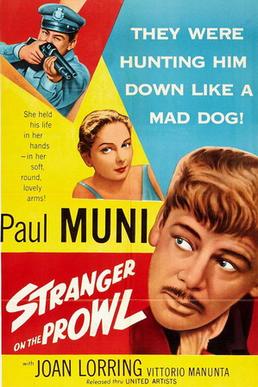Top Qs
Timeline
Chat
Perspective
Stranger on the Prowl
1952 Italian film From Wikipedia, the free encyclopedia
Remove ads
Imbarco a mezzanotte (internationally released as Stranger on the Prowl, also known as Giacomo and Encounter) is a 1952 Italian drama film directed by Joseph Losey and featuring Paul Muni.[1][2][3]
The picture was the first to be made abroad by any blacklisted Hollywood director.[4] Due to the political blacklist, Losey was credited for the story and direction under the name Andrea Forzano.[5][6]
Muni traveled to Italy to star in the film partly as an act of solidarity and support for blacklisted friends living there in exile.
Remove ads
Plot
A disillusioned vagrant (Paul Muni) kills a shop owner, and is joined by a rebellious youngster in his flight from apprehension.[7]
Cast
- Paul Muni as The Stranger With A Gun
- Joan Lorring as Angela, a lonely woman
- Vittorio Manunta as Giacomo, a small boy
- Luisa Rossi as Giacomo's Mother
- Aldo Silvani as Peroni, the junk dealer
- Arnoldo Foà as Inspector-in-Charge
- Alfredo Varelli as The Neighborhood Patrolman
- Héléna Manson as Grocery Store Clerk
- Enrico Glori as Signor Pucci
- Linda Sini as Signora Raffetto
Retrospective appraisal
Summarize
Perspective
“Stranger on the Prowl, made at the end of the neorealist revolution in Italian cinema, has the grainy texture and the naturalistic mood of the films by De Sica or Rosellini. Since it tells the story of a man and a boy, it contains echoes of De Sica’s The Bicycle Thief (1948). - Film critic Foster Hirsch in Joseph Losey (1980)[8]
Film historian Foster Hirsch considers the Stranger on the Prowl deserving of “more attention than it has received.”[9]
The film is clearly influenced by Italian neorealism and consequently is “markedly different” in its mise-en-scene from Losey’s previous Hollywood, and his subsequent British produced films, notably lacking in their claustrophobic “closed qualities.”[10] Hirsch writes:
The film is set in the cavernous, bombed-out [word missing] of a severely depleted post-war Italian slum…as in the major neo-realist films, Losey frames his action with a sense of the ongoing flow of life. The screen is almost always filled with background movement…Losey’s film “redeems” physical reality with its “open compositions.”[11]
Hirsch reserves special mention for American film star Paul Muni, who brings pathos and genuine dignity to the impoverished outcast and fugitive he portrays.[12]
Footnotes
Sources
External links
Wikiwand - on
Seamless Wikipedia browsing. On steroids.
Remove ads

